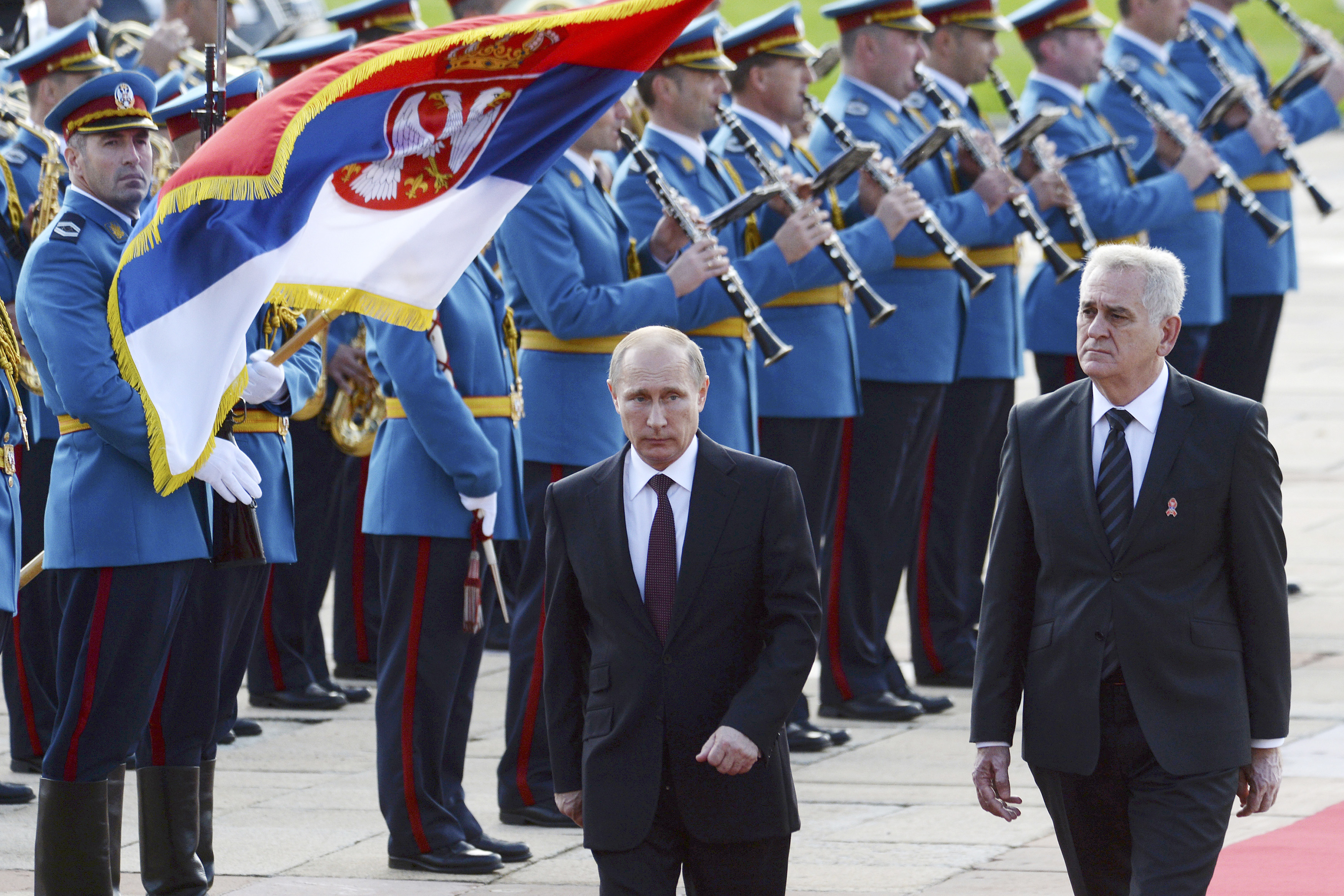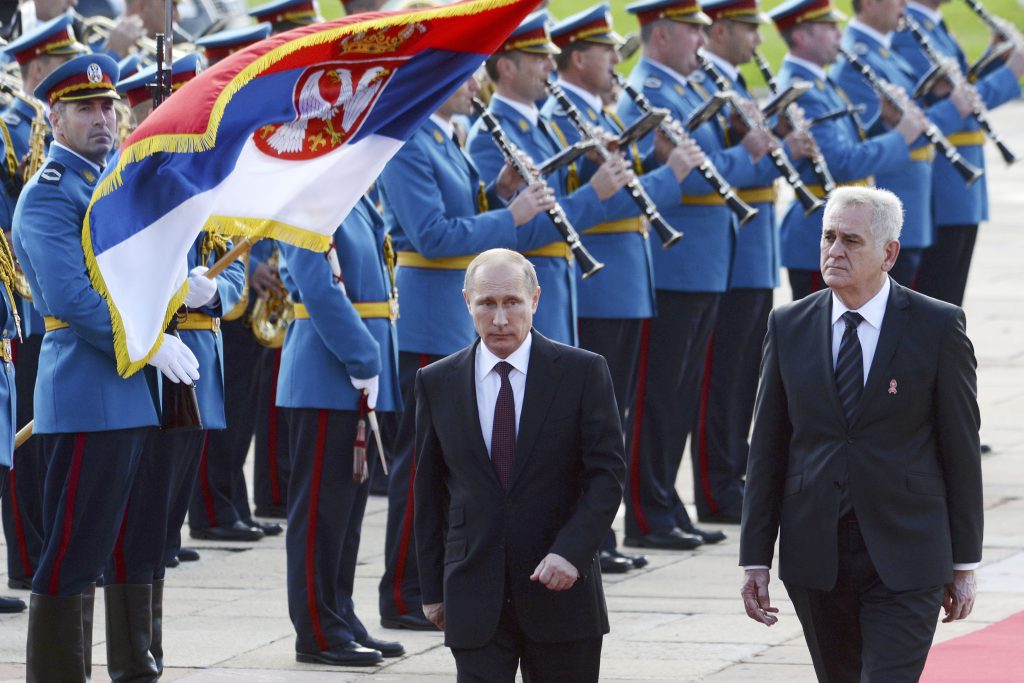
Buoyed by Successes in Europe’s East, Russia’s Leader Turns His Gaze to Serbia and Its Neighbors
Russian President Vladimir Putin’s attack on Ukraine aims to deny that nation a European future, partly by closing the door permanently to membership in NATO or the European Union. Putin’s aims, however, are not limited to extending a Russian sphere of influence over neighbors with Russian-speaking populations. Southeast Europe also figures in Putin’s plans to upend the post-Cold War order in Europe.
Putin is in Belgrade this week to celebrate the 70th anniversary of the city’s liberation from Nazi occupation by the Soviet army. But he is focused on the future. Russia first gained control of Serbia’s energy infrastructure. It then opened a base for emergency relief operations at the airport in Serbia’s city of Nis—a positive-sounding mission, but one run by Russia’s Ministry of Emergency Situations, which fulfills paramilitary and intelligence roles for the Kremlin.
Over the past year, Brussels has accelerated Serbia’s path to the EU in recognition of Belgrade’s positive steps toward forging a politically difficult settlement with Kosovo. In response, Moscow is working to outmaneuver the EU with its own diplomacy aimed at reminding Serbs of their historic ties to Russia and disrupting Serbia’s path to the EU and, ultimately, NATO. Since the Ukraine crisis, Moscow has intensified its charm offensive, dispatching its foreign and defense ministers and intelligence chief to pave the path for Putin this week.
Russia Pressures Montenegro
Russia is also active elsewhere in the region. In late September, Russian Foreign Minister Sergey Lavrov answered NATO leaders’ decision at their Wales summit to punt on any decision on membership for Montenegro until the end of 2015 by asserting that enlargement in the Balkans is a ‘provocative’ act.
Montenegro is awash with anti-NATO propaganda fueled by groups that likely trace their funding back to Moscow and the Orthodox Church. The church has become as effective a propaganda arm of the Kremlin as the state-run broadcast channel Russia Today. By undermining the Montenegrin government’s campaign to build public support for NATO membership, using corruption as a political weapon, and ensuring the Serb-dominated opposition refuses to compromise on the issue, Moscow hopes to spoil Montenegro’s candidacy.
Montenegro’s Prime Minister Milo Djukanovic has stood firm so far, rebuffing Moscow’s request to establish a Russian naval presence at its port of Bar and stepping up efforts to track former Russian intelligence officers settling along the country’s Adriatic coast. Montenegro has aligned its policies with NATO and the EU in the Ukraine crisis, agreeing to follow the sanctions regime, a step that Moscow labeled a “hostile” act. A Russian parliamentarian even suggested that Moscow target Montenegro with missiles.
Division as a Strategy
In Bosnia-Herzegovina, Russia is taking advantage of the federal governance structure created in the 1995 Dayton Accords to apply its long-used tactic of fueling separatist efforts to create permanently divided nations that are undesirable partners for NATO and the EU. With Putin’s political and financial backing, the ethnic Serb entity within Bosnia-Herzegovina, Republika Srpska, is blocking progress on Bosnia’s reforms with the aim of destroying a unitary state.
The net result is a stagnant Bosnia, sowing seeds of instability and potentially renewed violence. Russia is playing with fire, knowing that a conflagration is the best deterrent to NATO and EU enlargement.
Moscow is also fanning tensions in Kosovo as it steps up support for obstructionist, separatist Serbian groups there.
The Cold War ended badly in the Balkans, as bloody warfare marred the end of the former Yugoslavia. After great losses, the region settled into a stability premised on the vision that ultimately each nation in the Balkans could accede to NATO and the EU as it desired and when it met the standards. Slovenia joined NATO and the EU first, followed by Croatia and Albania joining NATO in 2009, and Croatia joining the EU in 2013. Today, Serbia, Montenegro, and Albania are making serious strides toward the EU, Montenegro is on the cusp of NATO membership, and Macedonia remains held up only by a dispute with Greece over its name.
Russia’s Slavic Appeal
But Putin seems intent on derailing this plan. Just as Moscow is waging a campaign to ensure its neighbors remain within its orbit, Russia is stepping back into Southeast Europe, aiming to leverage its religious and cultural ties to block states in the region from joining European and transatlantic institutions. Putin is extending his “compatriots” doctrine—which declares Russia’s right to protect Russian-speakers anywhere—to other Slavs. This argument portrays Russia as the defender of traditional Orthodox values and fosters an alternative ideology to the liberal democratic European model.
Part of a strategic response to deter Putin from further aggression should be a concerted transatlantic effort to consolidate the Balkans. This means inviting Montenegro to join NATO, refocusing on Bosnia after its elections to overcome a status quo which is a pathway to instability, redoubling efforts to advance Serbia’s European aspirations, and recommitting to settle Macedonia’s name dispute.
In the absence of a renewed transatlantic strategy, we may lose Europe’s southeast just as we risk losing Europe’s east.
Damon Wilson is executive vice president of the Atlantic Council.
Image: Russian President Vladimir Putin and Serbian President Tomislav Nikolic review a Serbian military honor guard in Belgrade October 16. Putin was Serbia’s guest of honor at a military parade and other ceremonies marking 70 years since the Belgrade’s liberation by the Soviet Red Army. Putin aims to maintain Russian influence in the Balkans as states in the region have joined the European Union and NATO. (REUTERS/Vasily Maximov)
